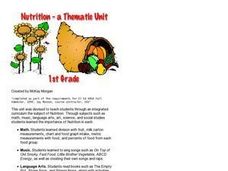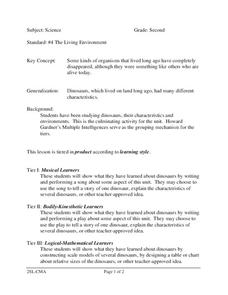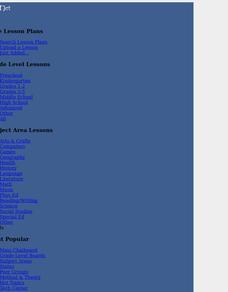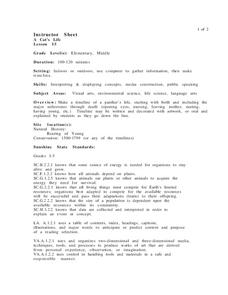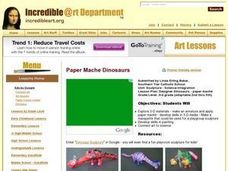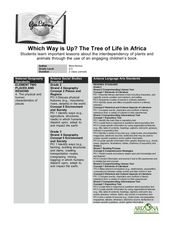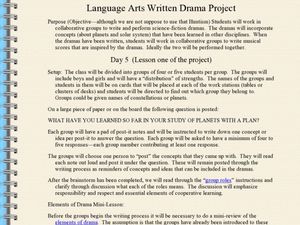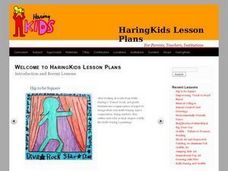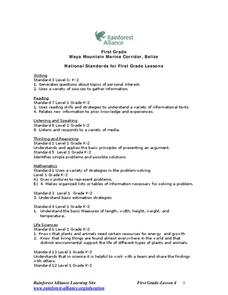Curated OER
Ornithology and Real World Science
Double click that mouse because you just found an amazing lesson plan! This cross-curricular Ornithology lesson plan incorporates literature, writing, reading informational text, data collection, scientific inquiry, Internet research,...
Curated OER
Nutrition: A Thematic Unit
Young learners explore nutrition and the food groups in these two mini-lesson plan ideas. First, kindergarteners have a discussion about their health and how different foods contribute to it before making their own personal food pyramid....
Curated OER
Insects
Students read books, learn about the letter i, and eat raisins that represent ants all to learn about insects. In this insects lesson plan, students also observe an ant farm and play follow the leader.
Curated OER
Science--"Water, Water Everywhere"--Exploring Liquids
In this water worksheet, students read a 1 page article on water, fill in the blanks of 3 words with their missing letters, fill in a crossword puzzle containing 5 clues about water and answer 1 short answer question. Students draw a...
Curated OER
Reading Predictions
Second graders read and predict content and purpose for table of contents, index, headings, captions, illustrations, and major words from their science or social studies textbooks. They use books' elements to summarize what they can find...
Curated OER
The Living Environment
In this reading comprehension lesson, 2nd graders have the choice between musical, kinesthetic, logical mathematical and verbal linguistic options to display their knowledge. Students can write a song, perform a play, construct a model...
Curated OER
I Love Spiders
Students read the book, I Love Spiders by John Parker. Then students enjoy different activities creating spiders and making a spider web room. Great for Halloween.
Curated OER
Pollution is Not a Solution
Young scholars explore the environment by completing science worksheets in class. In this water conservation lesson, students identify ways water is used in our society and how we abuse the privilege. Young scholars discuss methods to...
Curated OER
Cloudy With A Chance of Meatballs
Second graders explore weather. In this weather lesson, 2nd graders read Cloudy With A Chance of Meatballs and participate in four supplemental science activities. Students participate in Internet research, create weather maps,...
Curated OER
Circuits and Conductors
Students explore electricity by completing Internet activities. In this physical science instructional activity, students identify an electric circuit and describe the characteristics of conductors, giving examples as well. ...
Curated OER
Sunshine Math 3
In this word problems worksheet, learners read and problem solve nine mathematical word problems involving grids, measurement, compensation and angles.
Curated OER
Fall vs. Spring
Students learn about fall and spring by engaging in hands-on activities in order to fulfill science and language arts standards. In this lesson on seasons, students first listen to a story about fall, discuss the characteristics of the...
Curated OER
A Cat's Life
Students construct a timeline of a panther's life. Students decorate their timeline with illustrations and words, or they can choose to have it orally read to the class. Students use the computer to construct their time-lines. Students...
Curated OER
Designer Dinosaurs - Paper Maché
Third graders explore 3-D materials by making a macquette that could be used for a playgroup sculpture. The students design and execute papier-mâché dinosaurs. They develop painting skills and connect art to science.
Curated OER
Finger Painting and Feather Painting with Nature
Students explore finger painting and painting with feathers and recreate the look of objects in nature. They read the book, 'It Looked Like Spilt Milk,' create a shaving cream print, paint with feathers, and construct a mirror image on...
Curated OER
Coral Reef: Water Cycle Center
In this coral reef water cycle worksheet, students read 4 sections of a table the include sentences about the water cycle. They cut out the sentences and paste them on a poster that sequences the steps of the water cycle. They draw a...
Curated OER
The Fastest Pig in the West in the Classroom: Rice in China
Young scholars explore agriculture by reading a children's book in class. In this Chinese culture lesson, students read a chapter from the book The Fastest Pig in the West and identify the importance of rice in China's economy and...
Curated OER
Which Way is Up? The Tree of Life in Africa
Learners read a book titled This is the Tree about a baobab tree and draw a picture and label the tree. In this tree lesson plan, students also write a paragraph explaining why they drew that tree.
Curated OER
Language Arts Written Drama Project: Creationism
Learners create and perform science fiction drams based upon their knowledge of the solar system. In this solar system lesson students work in cooperative groups to create a short play and will also score the play.
Curated OER
Mixing Up Magic
Students explore the relationship between art and science through experimenting with color, design and recycled materials and creating their own art work.
Curated OER
Counting Crows
Students discuss the fable, The Crow and the Pitcher. In this literature instructional activity, students read the fable and create a crow sock puppet. Students use their puppets to dramatize the fable.
Curated OER
Making a Rainstick
Students construct a rainstick. In this music lesson, students investigate the history of the rainstick by reading the book Bringing the Rain to the Kapiti Plain by Verna Aardema. Students express their feelings about the rain and create...
Curated OER
The Frog and the Ol' Black Fly
Students explore frogs. In this cross curriculum literacy and frogs lesson plan, students predict the plot and then listen to the book The Wide-Mouthed Frog by Keith Faulkner. Students define "predator" and identify foods a frog...
Curated OER
Who Takes Care of the Maya Forest Corridor?
First graders study the animals in the Maya Forest Reserve. In this conservation instructional activity, 1st graders create a graph to compare the environment of animals to their own. They design a 3D model of these two environments.

